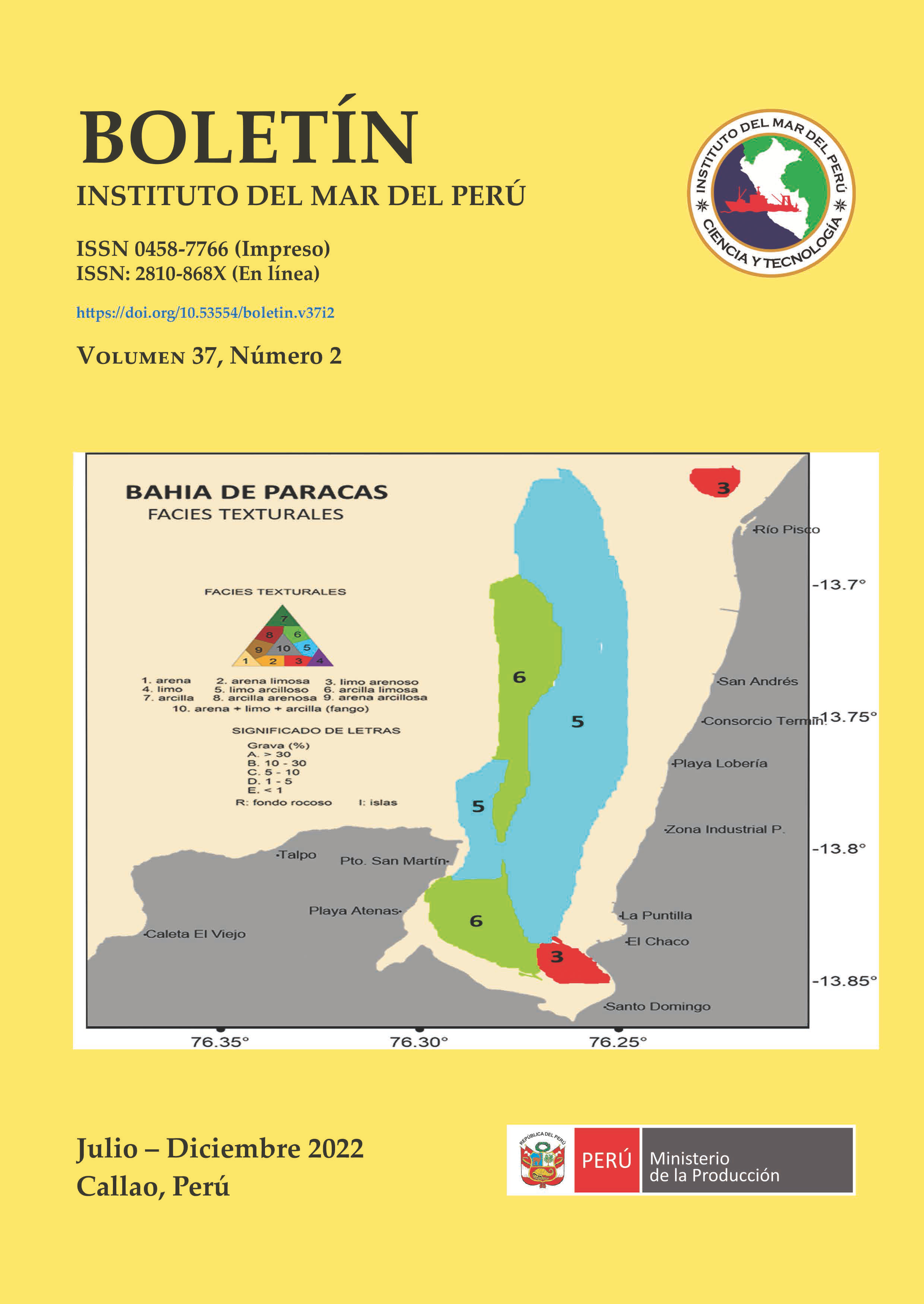Surface oceanographic conditions, zooplankton, ichthyoplankton, and euphausiids in the northern Peruvian sea (Autumn 2020)
DOI:
https://doi.org/10.53554/boletin.v37i2.369Keywords:
Oceanografia, Zooplancton, IctioplanctonAbstract
Our work aims to provide information on sea surface oceanographic conditions, zooplankton biovolumes,
ichthyoplankton composition, and euphausiid distribution between Puerto Pizarro and Pimentel - Chicama,
up to 50 nm offshore, in autumn 2020. Tropical Surface Waters (TSW), within 15 nm off Puerto Pizarro, and
Equatorial Surface Waters (ESW), between Talara and Punta Sal, occurred throughout this zone. The Cold
Coastal Waters (CCW) were within the 15 nm strip from Paita to Chicama and mixing waters (SSW+CCW)
were observed south of Paita. Dissolved oxygen values greater than 5.0 mL/L were associated with the
presence of the TSW, ESW, and SSW. Zooplankton biovolumes ranged from 1.0 to 23.0 mL/sample. From
Talara to the north of Punta Sal, values of 10.1 to 20.0 mL/sample were more frequent (48%). Zooplankton
biovolumes ranged from 1.0 to 23.0 mL/sample. From Talara to the north of Punta Sal, values of 10.1 to 20.0 mL/
sample were more frequent (48%). Regarding ichthyoplankton, eggs belonging to the family Synodontidae
and Engraulidae larvae were the most frequent (56%). Engraulis ringens eggs and larvae were homogeneously
distributed between Mórrope and Talara; Vinciguerria lucetia eggs and larvae were distributed between Paita
and Puerto Pizarro. We determined six species and 3 genera of mesopelagic fish larvae such as myctophids,
of which the species Diogenichthys laternatus was the most frequent and abundant. Merluccius gayi peruanus
eggs and larvae were also found in small concentrations. As for euphausiids, the most frequent species was
Nictyphanes simplex (68%) in adult and juvenile stages, followed by Euphausia lamelligera and E. mucronata
(20%). There was a predominance of calyptopis and furcilia stages, which are evidence of the reproductive
process of this group.
Downloads
Alternative Metrics
Metrics
References
Aronés, K., Correa, J. (2019). Biovolúmenes del zooplancton. Distribución y abundancia de eufáusidos e ictioplancton, frente a la costa peruana. Otoño 2016. Bol Inst Mar Perú, 34(2), 489-502.
Aronés, K., Nakazaki, C. (2019). Ictioplancton y eufáusidos frente a la costa peruana durante el otoño 2015. Bol Inst Mar Perú, 34(2), 473-488.
Aronés, K., Pinedo, E., Nakazaki, C. (2019). Ictioplancton y eufáusidos frente a la costa peruana, durante el otoño 2017. Bol Inst Mar Perú, 34(2), 503-518.
Boltovskoy, D. (Ed.). (1999). Zooplankton. South Atlantic. Backhuys Publishers, Leiden, I, II, 1706 pp.
Carrit, D. E., Carpenter, J. H. (1966). Comparison and evaluation of currently employed modifications of the Winkler method for determining dissolved oxygen in seawater. J. Mar. Res., 24, 286-318.
Comisión Multisectorial Encargada del Estudio Nacional del Fenómeno “El Niño” – ENFEN. (2020a). Comunicado Oficial ENFEN Nº 01-2020. http://enfen.gob.pe/download/comunicado-oficial-enfen-n-01-2020/?wpdmdl=1480&refresh=5e8726c2accb81585915586
Comisión Multisectorial Encargada del Estudio Nacional del Fenómeno “El Niño” – ENFEN. (2020b). Comunicado Oficial ENFEN Nº
Comisión Multisectorial Encargada del Estudio Nacional del Fenómeno “El Niño” – ENFEN. (2020c). Comunicado Oficial ENFEN Nº
Einarsson, H., Rojas de Mendiola, B. (1963). Descripción de huevos y larvas de anchoveta peruana (Engraulis ringens J.). Bol Inst Invest Recurs Mar, I(1), 1-23.
Kramer, D., Kalin, M. J., Stevens, E. G., Thrailkill, J. R., Zweifel, J. R. (1972). Collecting and processing data on fish eggs and larvae in the California Current region. NOAA Technical Report NMFS, Circ-370. U. S. Department of Commerce, NOAA, National Marine Fisheries Service: Seattle, WA. 38 pp.
Moser, H. (1996). The Early Stages of Fishes in the California Current Region. California Cooperative Oceanic Fisheries Investigations, Atlas Nº 33, 1505 pp.
Palomares, M. L., Muck, P., Mendo, J., Chumán, E., Gómez, O., Pauly, D. (1987). Growth of the Peruvian anchoveta (Engraulis ringens), 1953 to 1982. In Pauly, D. and I. Tsukayama, Editors. The Peruvian anchoveta and its upwelling ecosystem: three decades of change.
ICLARM Studies and reviews 15, 351, Instituto del Mar del Perú (IMARPE), Callao, Perú.
Rojas de Mendiola, B., Gómez, O. (1981). Daily otolith rings in otoliths of larval anchovy (Engraulis ringens). Rapp. P.V. Reun. Cons. Int. Explor. Mer., 178, 565-566.
Santander, H. (1981). Patrones de distribución y fluctuaciones de desoves de anchoveta y sardina. En: Dickiev Valdivia (eds.). Investigación cooperativa de la anchoveta y su ecosistema (ICANE) entre Perú y Canadá. Bol Inst Mar Perú, Vol. Extraordinario,
-192.
Santander, H., Sandoval de Castillo, O. (1981). Algunos indicadores biológicos del ictioplancton. En: Memorias, Seminario sobre indicadores biológicos del ictioplancton (8-11 Setiembre 1980), 89-103.
Santander, H., Sandoval de Castillo, O. (1973). Estudio sobre la primera etapa de vida de la anchoveta. Inf Inst Mar Perú, 4, 1-30.
Santander, H., Sandoval de Castillo, O. (1969). Desarrollo y distribución de huevos y larvas de merluza, Merluccius gayi (Guichenot) en la costa peruana. Bol Inst Mar Perú, 2 (3), 80-126.
Santander, H., Luyo, G., Carrasco, S., Veliz, M., Sandoval, O. (1981). Catálogo de zooplancton en el mar peruano, primera parte: Área Pisco-San Juan. Bol Inst Mar Perú, 6, 1-75.
van Guelpen, L., Markle, D. F., Duggan, D. J. (1982). An evaluation of accuracy, precision and speed of several zooplankton-subsampling techniques. Journal du Conseil International pour L’exploration de la Mer, 40, 226-236.
Downloads
Published
How to Cite
Issue
Section
License
Copyright (c) 2022 Boletin Instituto del Mar del Perú

This work is licensed under a Creative Commons Attribution 4.0 International License.










